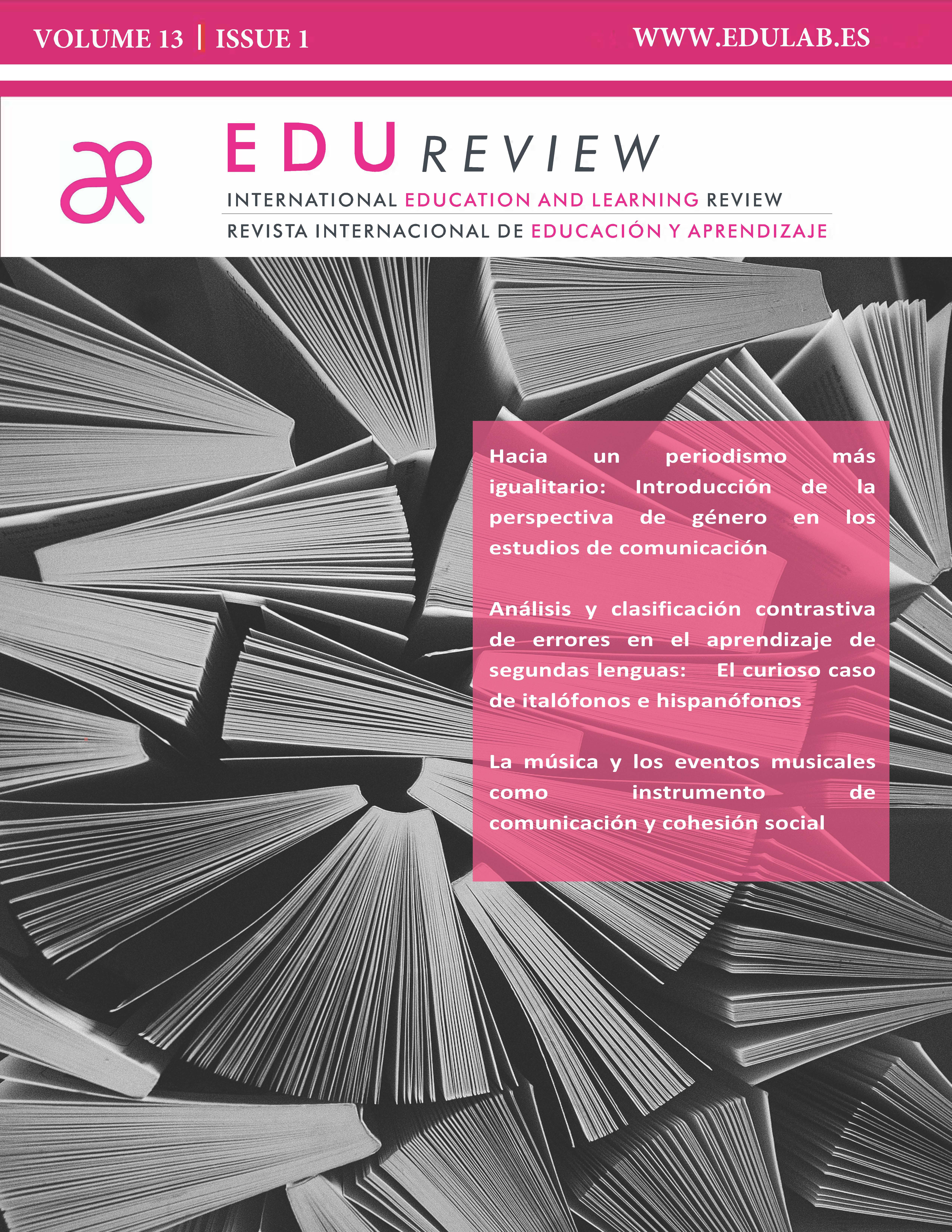Impacto de la estimulación olfativa en la interacción social y la capacidad comunicativa en aulas de educación superior
DOI:
https://doi.org/10.62701/revedu.v13.5443Palabras clave:
Olfato, Conciencia olfativa, Comunicación social, EmocionesResumen
El sentido del olfato, a menudo subestimado frente a otros sentidos, posee un papel fundamental en la experiencia humana. No solo permite identificar olores, sino que también influye en procesos emocionales, cognitivos y sociales. La conciencia olfativa —la capacidad de percibir y reaccionar ante señales olfativas— afecta actitudes y comportamientos, convirtiendo al olfato en un canal relevante para la comunicación social. Estudios demuestran que los olores pueden evocar recuerdos y emociones, moldeando la forma en que interactuamos con el entorno y con otras personas. Esta interacción entre el olfato y otros sistemas mentales revela su importancia en campos como la educación, la comunicación y la psicología. Comprender su funcionamiento y su impacto puede enriquecer estrategias comunicativas y pedagógicas, así como profundizar en el estudio del comportamiento humano.
Descargas
Estadísticas globales ℹ️
|
595
Visualizaciones
|
396
Descargas
|
|
991
Total
|
|
Citas
Abdelhalim, A. R. (2021). The effect of Mentha piperita L. on the mental health issues of university students: A pilot study. Journal of Pharmacy and Pharmacognosy Research, 9(1), 49-57. https://lc.cx/VlO0jN DOI: https://doi.org/10.56499/jppres20.932_9.1.49
Agredo Lemos, F. E. y Cuello Bueno, G. A. (2023). Olfato: forma más antigua de comunicación y sentido preciso que el otorrinolaringólogo debe conocer a profundidad. Acta de Otorrinolaringología y Cirugía de Cabeza y Cuello, 51(2), 137-142. https://doi.org/10.37076/acorl.v51i2.727 DOI: https://doi.org/10.37076/acorl.v51i2.727
Alcaide Casado, J. C., y Merino Sanz, M. J. (2011). Comunicación experiencial y sensorial: Algunos ejemplos de aplicación. Harvard Deusto Business Review, (198), 62-79. https://lc.cx/ZxahbI
Almatroodi, S. A., Alsahli, M. A., Almatroudi, A., Khan, A. A., y Rahmani, A. H. (2021). Peppermint, (Mentha× piperita): role in management of diseases through modulating various biological activities. Pharmacognosy Journal, 13(3). https://doi.org/10.5530/pj.2021.13.104 DOI: https://doi.org/10.5530/pj.2021.13.104
Baines, L. (2008). A Teacher's guide to multisensory learning: Improving literacy by engaging the senses. Association for Supervision and Curriculum Development.
Basto Gómez, E. S. (2015). Olor y derecho (Tesis doctoral). Universidad de Alicante, Alicante, España. https://lc.cx/t63ogy
Bensafi, M., Croy, I., Phillips, N., Rouby, C., Sezille, C., Gerber, J., ... y Hummel, T. (2014). The effect of verbal context on olfactory neural responses. Human Brain Mapping, 35(3), 810-818. https://doi.org/10.1002/hbm.22215 DOI: https://doi.org/10.1002/hbm.22215
Bratman, G. N., Bembibre, C., Daily, G. C., Doty, R. L., Hummel, T., Jacobs, L. F., ... y Spengler, J. D. (2024). Nature and human well-being: The olfactory pathway. Science Advances, 10(20), eadn3028. https://doi.org/10.1126/sciadv.adn3028 DOI: https://doi.org/10.1126/sciadv.adn3028
Briggs, P., Haerylack, H., y Mooney, R. (2017). Aceite de menta inhalado para las náuseas postoperatorias en pacientes sometidos a cirugía cardíaca. Nursing (Ed. española), 34(3), 40-46. https://doi.org/10.1016/j.nursi.2017.06.012 DOI: https://doi.org/10.1016/j.nursi.2017.06.012
Brumm, M. C., Pierz, K. A., Lafontant, D. E., Caspell-Garcia, C., Coffey, C., Siderowf, A., y Marek, K. (2023). Updated percentiles for the University of Pennsylvania smell identification test in adults 50 years of age and older. Neurology, 100(16), e1691-e1701. https://doi.org/10.1212/WNL.0000000000207077 DOI: https://doi.org/10.1212/WNL.0000000000207077
Castro, J. B., Ramanathan, A., y Chennubhotla, C. S. (2013). Categorical dimensions of human odor descriptor space revealed by non-negative matrix factorization. PloS ONE, 8(9), e73289. https://doi.org/10.1371/journal.pone.0073289 DOI: https://doi.org/10.1371/journal.pone.0073289
Cui, J., Li, M., Wei, Y., Li, H., He, X., Yang, Q., Li, Z., Duan, J., Wu, Z., Chen, Q., Chen, B., Li, G., Ming, X., Xiong, L., y Qin, D. (2022). Inhalation aromatherapy via brain-targeted nasal delivery: Natural volatiles or essential oils on mood disorders. Frontiers in Pharmacology, 13, 860043. https://doi.org/10.3389/fphar.2022.860043 DOI: https://doi.org/10.3389/fphar.2022.860043
Dal Bò, E., Gentili, C., Spoto, A., Bruno, G., Castellani, A., Tripodi, C., Fischmeister, F. P., y Cecchetto, C. (2021). The social odor scale: Development and initial validation of a new scale for the assessment of social odor awareness. PLoS One, 16(12), 1-17. https://doi.org/10.1371/journal.pone.0260587. DOI: https://doi.org/10.1371/journal.pone.0260587
Dufort, J. (2017). Aceites esenciales: Una guía práctica para conocer las propiedades de los aceites esenciales y sus aplicaciones. s.l.: Robinbook.
Dunn, W. (2014). Sensory profile 2. Psych Corporation.
Ferdenzi, C., Roberts, S. C., Schirmer, A., Delplanque, S., Cekic, S., Porcherot, C., Cayeux, I., Sander, D., y Grandjean, D. (2013). Variability of affective responses to odors: Culture, gender, and olfactory knowledge. Chemical Senses, 38(2), 75-186. https://doi.org/10.1093/chemse/bjs083 DOI: https://doi.org/10.1093/chemse/bjs083
Fjaeldstad, A., Fernandes, H. M., Van Hartevelt, T. J., Gleesborg, C., Møller, A., Ovesen1, T., y Kringelbach, M. L. (2017). Brain fingerprints of olfaction: a novel structural method for assessing olfactory cortical networks in health and disease. Scientific Reports, 7(42534). DOI: https://doi.org/10.1038/srep42534
Fuentes, A. y Collado, J. (2019). Fundamentos epistemológicos transdisciplinares de educación y neurociencia. Colección de la Educación, 26(1), 83-113. https://doi.org/10.17163/soph.n26.2019.02 DOI: https://doi.org/10.17163/soph.n26.2019.02
Gazzaniga, M. S. (2018). The consciousness instinct: Unraveling the mystery of how the brain makes the mind. s.l.:Farrar, Straus and Giroux.
Gottfried, J. A. (2010). Central mechanisms of odour object perception. Nature Reviews Neuroscience, 11(9), 628-641. https://doi.org/10.1038/nrn2883 DOI: https://doi.org/10.1038/nrn2883
Gottfried, J. A. y Zald, D. H. (2005). On the scent of human olfactory orbitofrontal cortex: meta-analysis and comparison to non-human primates. Brain Research Reviews, 50(2), 287-304. https://doi.org/10.1016/j.brainresrev.2005.08.004 DOI: https://doi.org/10.1016/j.brainresrev.2005.08.004
Gómez, F. S. J. (2016). La comunicación. Salus, 20(3), 5-6. https://lc.cx/KdF7n8
Gómez, S. y Hernández, S. (2020). El olfato en el marketing sensorial: estudio de caso de Zara Home. Revista de Marketing Aplicado, 24(2), 201-216. https://doi.org/10.17979/redma.2020.24.2.6986 DOI: https://doi.org/10.17979/redma.2020.24.2.6986
Gülpınar, M.A. (2005). The Principles of Brain-Based Learning and Constructivist Models in Education. Kuram Ve Uygulamada Egitim Bilimleri, 5, 299. https://lc.cx/xsC9Dp
Hernández Díaz, J. F. y Portilla Portilla, M. (2021). El aprendizaje: experiencia sensorial práctica y entendimiento. En: Portilla Portilla, M. y Zamudio Tobar, G. (Eds. científicas). Rutas de investigación en educación, pedagogía, cultura y tecnología (21-47). Editorial Universidad Santiago de Cali. https://lc.cx/M9n33y DOI: https://doi.org/10.35985/9786287501355.1
Hernández González, O. (2021). Aproximación a los distintos tipos de muestreo no probabilístico que existen. Revista Cubana de Medicina General Integral, 37(3). https://lc.cx/Ncke-J
Kennedy, D., Okello, E., Chazot, P., Howes, M., Ohiomokhare, S., Jackson, P., Haskell, C., Khan, J., Forster, J., y Wightman, E. (2018). Volatile terpenes and brain function: Investigation of the cognitive and mood effects of Mentha × Piperita L. essential oil with in vitro properties. Nutrients, 10(8), 1029. https://doi.org/10.3390/nu10081029 DOI: https://doi.org/10.3390/nu10081029
Larrea Killinger, C. (1997). La cultura de los olores: una aproximación a la antropología de los sentidos. Quito: Abya-Yala. https://lc.cx/Gkkpe-
Martín Moraleda, I. J. y Majós Cullel, A. (2021). La aplicación del marketing olfativo en el entorno comercial. Revista de Comunicación , Issue 154, 301-319. https://doi.org/10.15178/va.2021.154.e1353 DOI: https://doi.org/10.15178/va.2021.154.e1353
Moreno, R., y Mayer, R. (2007). Interactive multimodal learning environments: Special issue on interactive learning environments: Contemporary issues and trends. Educational psychology review, 19, 309-326. https://doi.org/10.1007/s10648-007-9047-2 DOI: https://doi.org/10.1007/s10648-007-9047-2
Morgado Bernal, I. (2012). Claves neurocientíficas de la enseñanza y el aprendizaje. s.l. Ministerio de Educación. https://lc.cx/KsvEEf
Moss, M., Hewitt, S., Moss, L. y Wesnes, K. (2008). Modulation of cognitive performance and mood by aromas of peppermint and ylang-ylang. International Journal of Neuroscience, 118(1), 59-77. https://doi.org/10.1080/00207450601042094 DOI: https://doi.org/10.1080/00207450601042094
Moss, M., Ho, J., Swinburne, S. y Turner, A. (2023). Aroma of the essential oil of peppermint reduces aggressive driving behaviour in healthy adults. Human Psychopharmacology: Clinical and Experimental, 38(2). 10.1002/hup.2865. https://lc.cx/qxAoqz DOI: https://doi.org/10.1002/hup.2865
Orecchioni, M., Matsunami, H., y Ley, K. (2022). Olfactory receptors in macrophages and inflammation. Frontiers in immunology, 13. https://doi.org/10.3389/fimmu.2022.1029244 DOI: https://doi.org/10.3389/fimmu.2022.1029244
Moya, C. (2023). Aspectos teóricos y prácticos de la perfumería. En S. Schvartzman y M. Cestilli (Eds.), Dermatocosmética II: Criterios de formulación (2ª ed., 218-233). Córdoba: Universidad Católica de Córdoba.
Park, N., Chung, J. Y., Kim, M. H., y Yang, W. M. (2022). Protective effects of inhalation of essential oils from Mentha piperita leaf on tight junctions and inflammation in allergic rhinitis. Frontiers in Allergy, 3(1012183). https://doi.org/10.3389/falgy.2022.1012183 DOI: https://doi.org/10.3389/falgy.2022.1012183
Perry, R., Terry, R., Watson, L. K., & Ernst, E. (2012). Is lavender an anxiolytic drug? A systematic review of randomised clinical trials. Phytomedicine, 19(8–9), 825–835. https://doi.org/10.1016/j.phymed.2012.02.013 DOI: https://doi.org/10.1016/j.phymed.2012.02.013
Roberts, S. C., Havlíček, J., y Schaal, B. (2020). Human olfactory communication: Current challenges and future prospects. Philosophical Transactions of the Royal Society B, 375(1800), 20190258. https://doi.org/10.1098/rstb.2019.0258 DOI: https://doi.org/10.1098/rstb.2019.0258
Rodríguez-Gil, G. (2004). El Poderoso Sentido del Olfato. ReSources Primavera, 11(2), 1-3. https://lc.cx/oJyxX_
Rubio Gil, Á., Fernández de Alarcón Roca, B., y González Arnedo, E. A. (2023). El marketing olfativo en el nuevo hotel experiencial: Un estudio a través de las opiniones del sector hotelero y su clientela. Cuadernos de Turismo, (51), 19–49. https://doi.org/10.6018/turismo.571451 DOI: https://doi.org/10.6018/turismo.571451
Sánchez-González, O., Moya-Cano, A. y Moreno-Clemente, C. (2024). La aplicación de una experiencia olfativa como recurso educativo para el desarrollo de habilidades y competencias transversales dentro de la comunicación empresarial. Revista de Ciencias de la Comunicación e Información,29. https://doi.org/10.35742/rcci.2024.29.e287 DOI: https://doi.org/10.35742/rcci.2024.29.e287
Sattayakhom, A., Wichit, S., y Koomhin, P. (2023). The effects of essential oils on the nervous system:A scoping review. Molecules, 28(9), 3771 https://doi.org/10.3390/molecules28093771 DOI: https://doi.org/10.3390/molecules28093771
Severiano-Pérez, P. (2019). ¿Qué es y cómo se utiliza la evaluación sensorial? Interdisciplina, 7(19), 47-68. https://doi.org/10.22201/ceiich.24485705e.2019.19.70287 DOI: https://doi.org/10.22201/ceiich.24485705e.2019.19.70287
Sosa-García, L. I., Celis-López, E., Granados Ramos, D. E., Ortega-Herrera, M. E., Cruz Huerta, E., y Martínez, A. J. (2021). Bases neurobiológicas de los estímulos olfativos asociados a procesos cognitivos, preferencia y trastornos alimentarios. Cuadernos de Neuropsicología / Panamerican Journal of Neuropsychology, 15(2), 70-82. DOI: 10.7714/CNPS/15.2.206. https://lc.cx/HdMRvQ
Stevenson, R. J. (2010). An initial evaluation of the functions of human olfaction. Chemical senses, 35(1), 3-20. https://doi.org/10.1093/chemse/bjp083 DOI: https://doi.org/10.1093/chemse/bjp083
Sullivan, R., Perry, R., Sloan, A., Kleinhaus, K., y Burtchen, N. (2011). Infant bonding and attachment to the caregiver: Insights from basic and clinical science. Clinics in Perinatology, 38(4), 643-655. https://lc.cx/-JDzjv DOI: https://doi.org/10.1016/j.clp.2011.08.011
Tian, L., Hu, T., Zhang, S., Zhang, H., Yang, C., Chen, G., & Pan, S. (2022). A comparative study on relieving exercise-induced fatigue by inhalation of different citrus essential oils. Molecules, 27(10), 3239. https://doi.org/10.3390/molecules27103239 DOI: https://doi.org/10.3390/molecules27103239
Vila Casanovas, R. (2019). Aceites esenciales y estado de ánimo. Revista de Fitoterapia, 18(2), 101-136. http://hdl.handle.net/2445/159478
Villanueva Sánchez, H. (2017). El olfato como refuerzo experiencial. Aproximación cualitativa al branding olfativo en el sector hotelero [Doctoral dissertation, Universidad Camilo José Cela]. http://hdl.handle.net/20.500.12020/243
Zull, J. E. (2002). The art of changing the brain: Enriching the practice of teaching by exploring the biology of learning. Routledge. https://doi.org/10.4324/9781003447573 DOI: https://doi.org/10.4324/9781003447573
Descargas
Publicado
Cómo citar
Número
Sección
Licencia
Derechos de autor 2025 Los autores/as conservan los derechos de autor y ceden a la revista el derecho de la primera publicación y el derecho de edición

Esta obra está bajo una licencia internacional Creative Commons Atribución-SinDerivadas 4.0.
Los autores/as que publiquen en esta revista aceptan las siguientes condiciones:
- Los autores/as conservan los derechos de autor.
- Los autores/as ceden a la revista el derecho de la primera publicación. La revista también posee los derechos de edición.
- Todos los contenidos publicados se regulan mediante una Licencia Atribución/Reconocimiento-SinDerivados 4.0 Internacional. Acceda a la versión informativa y texto legal de la licencia. En virtud de ello, se permite a terceros utilizar lo publicado siempre que mencionen la autoría del trabajo y a la primera publicación en esta revista. Si transforma el material, no podrá distribuir el trabajo modificado.
- Los autores/as pueden realizar otros acuerdos contractuales independientes y adicionales para la distribución no exclusiva de la versión del artículo publicado en esta revista (p. ej., incluirlo en un repositorio institucional o publicarlo en un libro) siempre que indiquen claramente que el trabajo se publicó por primera vez en esta revista.
- Se permite y recomienda a los autores/as a publicar su trabajo en Internet (por ejemplo en páginas institucionales o personales), una vez publicado en la revista y citando a la misma ya que puede conducir a intercambios productivos y a una mayor y más rápida difusión del trabajo publicado (vea The Effect of Open Access).













